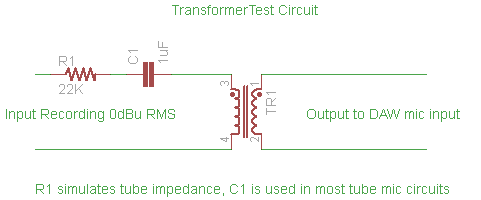The Book of Laminations

(Ok so I kind of stole the title "Lamentations")
*Laminations for the purpose of this article are the layers of iron or other special metals that are stacked up to make the core of a transformer
Among the DIY crowd I hear talk about the need for new transformers in a mic. The question occurred to me: Can we really hear the differences that these transformers make? And of course for me, if we hear a difference, I want to know WHY we hear a difference. In other words can we measure it understand it and re-create it when we want that sound.
The reason I ask is I once gave a box with a Hammond 804 transformer in it and two XLR connectors to a producer friend and asked him to tell me what he thought of the sound of this transformer. He went to his home studio and connected it between his synths, both analogue and digital, and his 1073 input module. He gave it a good listen and the next day when I asked what he heard he said... "Nothing. There was really no difference". I always knew that the 804 was good transformer so I was simultaneously sad and happy and his reply. I knew that those transformers were very transparent but are all transformers that way?
You know there are some microphones, by some pretty famous companies that have NO transformers in them. Why are we discussing transformers in the year 2014 anyway. Aren't they obsolete?
So we took it upon ourselves to try and get a sense of what a transformer sounds like and maybe even a little bit about why. There are people on the planet who know much more about this than we do, but what we will try to do is measure and listen and try to get some understanding of how important, or not, a transformer is in making a quality microphone.
As we have mentioned before, the primary role of a transformer in a tube mic or even a FET mic is to allow a high impedance device to create a low impedance signal. The transformer is doing an impedance "transformation" that makes this possible. Without that transformation the output signal of a tube or FET, if asked to connect to a low impedance input, would be low level and distorted at normal operating levels.
Test Method
We have taken 40 seconds of an Appalachian style tune we produced for a Canadian singer song/writer named Julie Rains. (available on iTunes) We re-mixed the tune in mono and brightened it up just a little to help with comparisons.
We took that Master track and played it from our DAW into a passive tube simulator circuit that connected to the transformer under test (TUT). The circuit for the test was very simple as is shown here:

Why this circuit? Well the resistor stands in for the output impedance of the tube. 22K ohms is similar to a 6072 tube. The 1uF capacitor was chosen because it is a common value used in tube mic circuits. And the capacitor and the coil of the transformer actually create something special called "resonance" when connected together.
So we are simulating what a real tube mic output has:
- A characteristic Impedance
- DC blocking capacitor
- Inductance (the transformer coils)
All are needed to really hear what the transformer is going to sound like in a mic. And yes we could have built a little tube circuit, but these passive parts were simpler and anyone can reproduce this to compare these results.
We took the output of the "transformer under test" (TUT) and fed it back into the mic input of our DAW and re-recorded it.
And we drove the transformer pretty hard, but not at maximum level. We fed in 0 dbu (.775 volts RMS). So peaks would be hitting about +8dB above that level at the most because there is some limiting on the track.
This is about the same as a singer hitting a mic with 100dB of sound, in round figures, on a tube microphone that used one of these transformers.
The transformers chosen were the type that would be used with a 12AY7/6072 tube. They have turns ratios of between 12:1 and 10.5:1, so very similar in that regard.
That's it. The only difference between the master track and the new track was that it passed through our little transformer circuit.
So on the next page have a set of results that consist of the sound of the recording that passed through the transformer and a frequency response graph of the transformer that you are hearing.
The results might surprise you ... or maybe not.
If you have any comments for us send them to :
